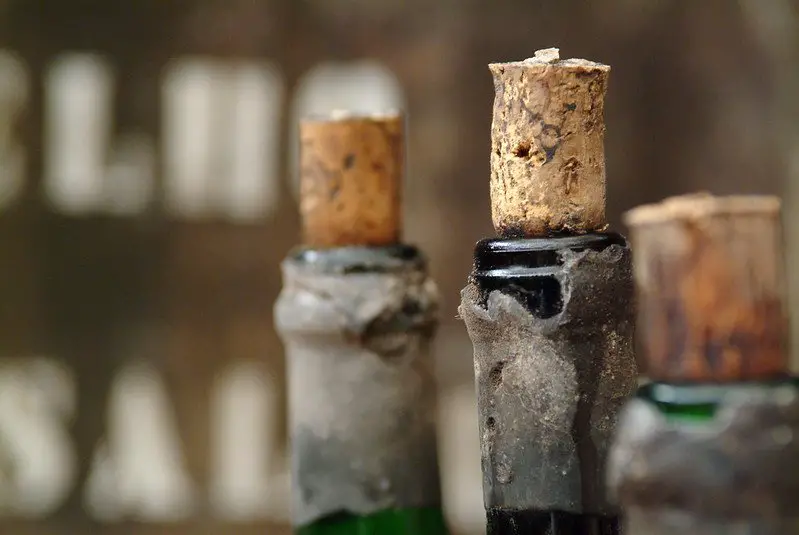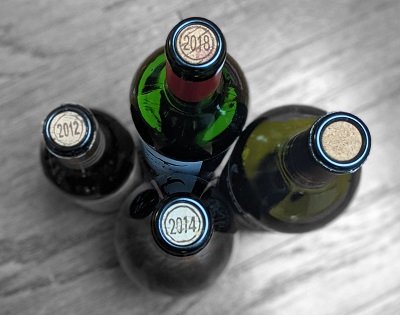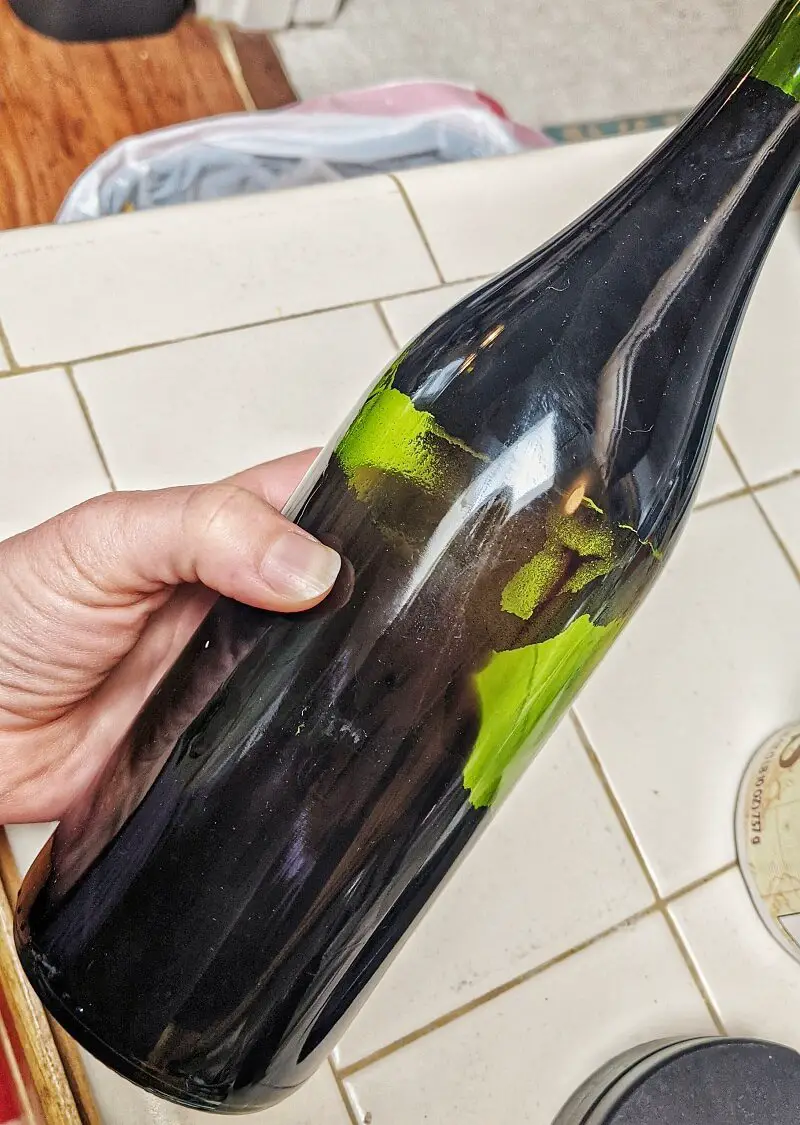
One of the delightful truths about being a wino is that curious bottles wind up in your hands. I was recently gifted a mysterious unlabeled bottle of 2009 (maybe) Syrah (also maybe). This led me to dive into the world of old wine.
Old wine smells like dried fruit aromas (potpourri and dried fig), and likely savory notes: jerky, tobacco, and leather. Wine aromas fade with time, leaving old wine smelling more alcoholic. Old wines aren’t bad wines. A bad wine will smell like varnish or nail polish remover or vinegar.
Here’s what you need to know about what old wine smells like.
- What Does Young Wine Smell Like?
- Is Old Wine Bad?
- What Does Old Wine Smell Like?
- Old Wines Smell More Alcoholic
- Can Young Wines Have Aged Wine Aromas?
- Why Are Some Wines Aged Before Being Sold?
- How to Taste Aged Wines: 3 Fun Options
- Case Study: Old Wine Mystery Bottle
- Final Thoughts – Aged Wines Smell Unique
- Thirsty for More?
What Does Young Wine Smell Like?

Before getting into what old wine smells like, it’s helpful to know the starting point: Young Wine.
Young wines that are in their primary drinking window will have fresh fruit aromas.
- For red wines, this may include crunchy or jammy red and black fruits, like raspberry, black currant, plum, and cherry.
- For white wines, these include aromas like zesty citrus, apple, white flower, and tropical or stone fruits.
In young wines, the alcohol shouldn’t be readily apparent – meaning that it doesn’t dominate when you take a deep sniff.
Side note: Some young wines smell really alcoholic. This means that the wine is out of balance and not very well made. 🙁
Is Old Wine Bad?
Old wine carries unique characteristics and aromas that develop over time. While it may have distinct qualities, such as dried fruit aromas and savory notes, it shouldn’t be mistaken for a spoiled or bad wine.
Now that you know what young wine smells like, it’s important to separate old wine from bad wine.
Old wine is, well, old.
Old wine has been aged for a number of years in the bottle or forgotten in the back of your closet.
There’s nothing wrong with being old. It happens to the best of us.
Bad wine, or spoiled wine, is no longer suitable for drinking.
Maybe you left a half bottle on the counter for a week or two, or maybe you found a bottle with a leaky cork in your cupboard.
A bad wine will smell like vinegar, or worse, nail polish remover.
Bad wine can be young or old.
You can usually tell a wine that’s gone off by giving it a good sniff. A bad wine won’t smell like much at all; the fruity aromas will seem muted or dull.
Helpful Tip: Dive into the world of the term “vintage” wines. Just how old does a wine need to be before it’s “vintage”? Find out here.
What Does Old Wine Smell Like?

Time does a few things to wine.
First, those vibrant, fresh fruit aromas, called primary aromas, transform and take on dried fruit qualities. Your juicy black cherry will become dried cherry. Your crisp green apple changes into dried apple.
Old wines also develop savory notes.
Chocolate and coffee or mocha notes in younger wines can convert into leather, dried tobacco, or jerky (dried meat).
All wine will eventually turn into vinegar.
Wine itself is a magical elixir suspended for a brief period of time between grape juice and vinegar.
Old wines begin to exhibit more vinegary notes, so expect to pick up balsamic qualities in older wines.
This isn’t necessarily unpleasant.
Old Wines Smell More Alcoholic

Given enough time, the fruity aromas, whether fresh or dried, fade. The more powerful and concentrated a young wine’s fruitiness, the longer the wine will be able to age favorably.
Entry-level and mid-priced wines lack the intensity that will allow them to age in the bottle over decades.
You will pick up more alcohol notes in old wine than in younger wines.
When the fruit aromas fade in aged wine, the alcohol remains.
Can Young Wines Have Aged Wine Aromas?
Sometimes a younger wine can have aged aromas and smell older than they really are. You’ve probably seen those wine fridges (or maybe even own your own wine fridge) or seen pictures of dark, dank wine cellars.
A consistent, cool temperature slows down the rate of aging for a wine.
There’s a good reason that wine cellars need to be cool. A hot car, a storage shed, or a store window can all expose the wine to heat and artificially age the wine.
Helpful Tip: Here’s a post that covers what you need to know about refrigerating your wines.
Those fresh, fruity flavors will quickly become dried up.
Pro tip: If you’re out buying wine and have a choice between a bottle up towards the top shelf, in the window display, or back in the dark corner – choose the bottle in the dark corner.
Why Are Some Wines Aged Before Being Sold?
Some wines go through aging back in the winery. Producers can age their wines back in the winery before they release them for purchase. This can help the wine develop complexity by introducing old wine aromas.
Aging the wine before releasing it will increase the cost of production and translate into higher per-bottle prices for you as a wine lover.
However, a producer may choose to age the wine knowing that most consumers don’t want to buy a bottle of wine and then hold onto it for several years before being able to pop the cork.
How to Taste Aged Wines: 3 Fun Options
If you’re looking to taste aged wines, you’re in luck! Some famous wine producing regions require significant aging before they’re released onto the market as part of their unique wine style.
This means that you can find wines with aged aromas without having to age them yourself for years (or even decades).
Here are a few fun pre-aged wines worth checking out:
- Frasquiera Madeira: Madiera is a fortified wine made on the island of Madiera owned by Portugal. Frasquiera Madeira is a producer’s flagship wine. The regulations stipulate that the wine is aged for an impressive 20 years in wood. These wines express complex dried fruit notes with high acid and sweetness to balance them out. Expect to pay $$ for these wines, but well worth it if you’re looking for a true, aged wine experience.
- Grand Reserva Rioja: This red wine made in Spain’s Rioja region is made of a blend of grapes, but primarily Tempranillo and Garnacha (Grenache). With a 5-year minimum aging requirement, Grand Reserva Rioja has classic tobacco, leather, dried red cherry, and potpourri notes. Yum! Here’s a complete guide to Tempranillo wine.
- Brunello di Montalcino Riserva: This red wine comes from the Montalcino region in Tuscany and is made using 100% Sangiovese. Expect a complex mix of dried red and black fruit, along with savory notes of leather and tobacco. This wine needs to be aged 6 years before release.
Case Study: Old Wine Mystery Bottle
(Maybe a 2009 Syrah from Monterey, CA – maybe not)

Immediately when you pour this wine, you know it has age. The wine sediment is so thick, that it coats the inside of the bottle and doesn’t look like I poured anything out at all!
On the nose:
- Kalamata olive
- Prune
- Fig
- Soy Sauce
- Smoked Jerky
- Leather
- Balsamic vinegar
- Alcohol
Passed its prime? Yeah, unfortunately. But fun to taste? Absolutely!
Final Thoughts – Aged Wines Smell Unique
As you continue your exploration in the world of wine, you’ll inevitably stumble upon intriguing old bottles.
As wines age, their aromas undergo a remarkable transformation, transitioning from fresh fruit to dried fruit notes, accompanied by savory elements such as tobacco and leather.
While old wines may exhibit more pronounced alcoholic qualities, it is crucial to differentiate them from spoiled wines with unpleasant aromas like vinegar or nail polish remover.
Thirsty for More?
Tawny Port is another distinctive wine that embraces aged qualities. Check out this post that does a deep-dive on Tawny Port wine.
If you’re just getting into wine, then I invite you to explore this 30-second tasting tip: How Do You Identify Red Wine Fruit Flavors?




